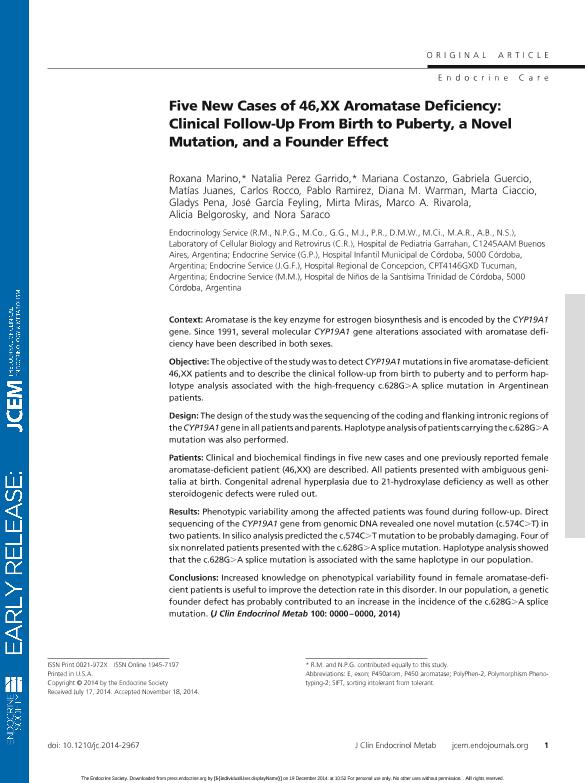Artículo
Five new cases of 46, XX aromatase deficiency: Clinical follow-up from birth to puberty, a novel mutation, and a founder effect
Marino, Roxana Marcela; Garrido, Natalia Perez; Costanzo, Mariana; Guercio, Gabriela Viviana ; Juanes, Matías Hernan
; Juanes, Matías Hernan ; Rocco, Carlos Alberto
; Rocco, Carlos Alberto ; Ramirez, Pablo; Warman, Diana M.; Ciaccio, Marta; Pena, Gladys; Feyling, José García; Miras, Mirta Beatriz; Rivarola, Marco Aurelio
; Ramirez, Pablo; Warman, Diana M.; Ciaccio, Marta; Pena, Gladys; Feyling, José García; Miras, Mirta Beatriz; Rivarola, Marco Aurelio ; Belgorosky, Alicia
; Belgorosky, Alicia ; Saraco, Nora Isabel
; Saraco, Nora Isabel
 ; Juanes, Matías Hernan
; Juanes, Matías Hernan ; Rocco, Carlos Alberto
; Rocco, Carlos Alberto ; Ramirez, Pablo; Warman, Diana M.; Ciaccio, Marta; Pena, Gladys; Feyling, José García; Miras, Mirta Beatriz; Rivarola, Marco Aurelio
; Ramirez, Pablo; Warman, Diana M.; Ciaccio, Marta; Pena, Gladys; Feyling, José García; Miras, Mirta Beatriz; Rivarola, Marco Aurelio ; Belgorosky, Alicia
; Belgorosky, Alicia ; Saraco, Nora Isabel
; Saraco, Nora Isabel
Fecha de publicación:
02/2015
Editorial:
Endocrine Society
Revista:
Journal of Clinical Endocrinology and Metabolism
ISSN:
0021-972X
Idioma:
Inglés
Tipo de recurso:
Artículo publicado
Clasificación temática:
Resumen
Context: Aromatase is the key enzyme for estrogen biosynthesis and is encoded by the CYP19A1 gene. Since 1991, several molecular CYP19A1 gene alterations associated with aromatase deficiency have been described in both sexes. Objective: The objective of the study was to detect CYP19A1 mutations in five aromatasedeficient 46, XX patients, to describe the clinical follow-up from birth to puberty and to perform haplotype analysis associated with the high-frequency c.628G>A splice mutation in Argentinean patients. Design: The design of the study was the sequencing of the coding and flanking intronic regions of the CYP19A1 gene in all patients and parents. Haplotype analysis of patients carrying the c.628G>A mutation was also performed. Patients: Clinical and biochemical findings in five new cases and one previously reported female aromatase-deficient patient (46, XX) are described. All patients presented with ambiguous genitalia at birth. Congenital adrenal hyperplasia due to 21-hydroxylase deficiency as well as other steroidogenic defects were ruled out. Results: Phenotypic variability among the affected patients was found during follow-up. Direct sequencing of the CYP19A1 gene from genomic DNA revealed one novel mutation (c.574C>T) in two patients. In silico analysis predicted the c.574C>T mutation to be probably damaging. Four of six nonrelated patients presented with the c.628G>A splice mutation. Haplotype analysis showed that the c.628G>A splice mutation is associated with the same haplotype in our population. Conclusions: Increased knowledge on phenotypical variability found in female aromatase-deficient patients is useful to improve the detection rate in this disorder. In our population, a genetic founder defect has probably contributed to an increase in the incidence of the c.628G>A splice mutation.
Palabras clave:
Aromatase
,
Aromatase Deficiency
,
Founder Effect
Archivos asociados
Licencia
Identificadores
Colecciones
Articulos(SEDE CENTRAL)
Articulos de SEDE CENTRAL
Articulos de SEDE CENTRAL
Citación
Marino, Roxana Marcela; Garrido, Natalia Perez; Costanzo, Mariana; Guercio, Gabriela Viviana; Juanes, Matías Hernan; et al.; Five new cases of 46, XX aromatase deficiency: Clinical follow-up from birth to puberty, a novel mutation, and a founder effect; Endocrine Society; Journal of Clinical Endocrinology and Metabolism; 100; 2; 2-2015; E301-E307
Compartir
Altmétricas



